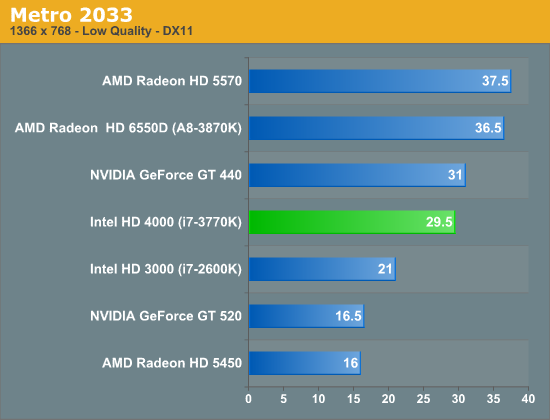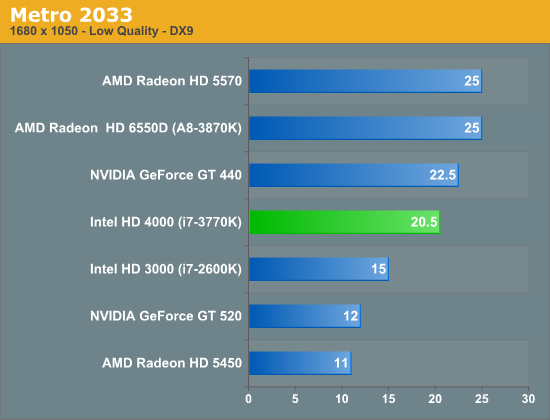The Ivy Bridge Preview: Core i7 3770K Tested
by Anand Lal Shimpi on March 6, 2012 8:16 PM EST- Posted in
- CPUs
- Intel
- Core i7
- Ivy Bridge
Metro 2033
The heaviest test we'll show in this suite, Metro 2033 still requires a discrete GPU for reasonable performance. That being said, it's still an interesting measure of how much more GPU horsepower exists in Ivy Bridge:



Here the Llano gap shrinks to about 13 - 25% depending on the resolution/quality settings. AMD still has the clear advantage in GPU performance, but Intel does step closer. The performance advantage over Sandy Bridge ranges from 20 - 40%. With these sorts of numbers it's clear why Intel views Ivy Bridge as being a tick+. Generational performance improvements on the CPU side generally fall in the 20 - 40% range. As you've just seen, Ivy Bridge offers a 7 - 15% increase in CPU performance over Sandy Bridge - making it a bonafide tick from a CPU perspective. The 20 - 40% increase on the graphics side is what blurs the line between a conventional tick and what we have with Ivy Bridge.










195 Comments
View All Comments
BoFox - Wednesday, March 7, 2012 - link
There are three different versions of HD 5570 (DDR2, DDR3, and GDDR5 - with the GDDR5 having FIVE times as much bandwidth as the DDR2 version).There are also two different versions of HD 5450 (DDR2 and DDR3).
It would be appreciated if you could let us know which versions were used in the benchmarks in this article. Thanks
BoFox - Wednesday, March 7, 2012 - link
Just let us know which GPU was used for the discrete GPU tests! LOL..KZ0 - Wednesday, March 7, 2012 - link
"ATI Radeon HD 5870 (Windows 7)", page 4:)
WiZARD7 - Wednesday, March 7, 2012 - link
There should be a comparison at the same clock speed - nehalem - sandy bridge - ivy bridge (@4 Ghz )Breach1337 - Wednesday, March 7, 2012 - link
On page, shouldn't:" Doing so won't give you access to some of the newer 7-series chipset features like PCIe Gen 3 (some 6-series boards are claiming 3.0 support), native USB 3.0 (many 6-series boards have 3rd party USB 3.0 controllers) and Intel's Rapid Start Technology."
say
" Doing so will give you access to some of the newer 7-series chipset features like PCIe Gen 3 (some 6-series boards are claiming 3.0 support), native USB 3.0 (many 6-series boards have 3rd party USB 3.0 controllers) and Intel's Rapid Start Technology."
iwod - Wednesday, March 7, 2012 - link
There are many thing not mentioned.Intel are strong in Software everywhere except the Gfx drivers department. No wonder why others call Anand a pro Intel site, i dont want to believe it, until all the article continue to label Intel are hard at work on Gfx drivers when they are clearly not. They are better then what they are used to be, but still far from good.
Graphics Quality on Intel IGP are not even close to what AMD offers.
Even if Haswell double the performance of Ivy they will still be one generation behind AMD.
I continue to wonder why they use their own GPU on Desktop / Laptop and not on Mobile SoC. They could have used PowerVR on Desktop as well, developing drivers for one hardware will simplify things and hopefully have bigger incentive to increase software R&D.
meloz - Wednesday, March 7, 2012 - link
>>No wonder why others call Anand a pro Intel siteWhat should he do, fake the benchmark results to make AMD look better than they are? Anand can only report his findings, he does this truthfully. Some people do not want to accept reality and prefer to shoot the messenger. Direct your frustrations towards AMD, not websites which report results of benchmarks.
From past benchmarks you can see the results at Anandtech are that different from other websites, AMD is getting destroyed on CPU perfomance and performance / watt metric.
>>I continue to wonder why they use their own GPU on Desktop / Laptop and not on Mobile SoC. They could have used PowerVR on Desktop as well,
FYI, they are dumping PowerVR in near future as well. Already covered on many websites, google it. PowerVR was a temporary fix, or rather an attempt at a fix which was more of a hassle and didn't work in the marketplace anyway.
They are now comitted to improving their own iGPU and drivers. This will take time for sure, Intel marches to its own beat.
The simple fact is that with the much weaker Sandy Brdige iGPU they outsold AMD 15 to 1, so even though the Ivy Bridge iGPU has not surpassed AMD yet, Intel should continue to do really well.
>>i dont want to believe it, until all the article continue to label Intel are hard at work on Gfx drivers when they are clearly not.
You can believe whatever you want to believe, this is not about beliefs but facts. As a user of Sandy Bridge and linux I know better than most just how much Intel drivers suck. In fact, their linux iGPU drivers suck much worse than Windows version (hard to imagine, but true) and weren't truly ready until Mesa 8.0, more than a year after release of the hardware.
But I also know they are working on things like SNA which in early test already offers ~20% performance boost.
No word on when it will be consumer ready, but Intel are working and steadily improving on drivers side as well. Perhaps not at the pace you want. You do not have to accept reality if it is so difficult for you, don't blame websites for reporting reality, however.
I am almost grateful Intel is not 'good enough' on GPU side as yet. It keeps AMD alive another year. Hopefully.
meloz - Wednesday, March 7, 2012 - link
>>From past benchmarks you can see the results at Anandtech are that different from other websitesShould read: From past benchmarks you can see the results at Anandtech are NOT that different from other websites.
Sigh, allow us to edit posts, if only for 10 minutes or so after making the initial post.
ET - Wednesday, March 7, 2012 - link
PowerVR has lower performance and fewer features, so would not be a good PC solution. I'm also sure that Intel would rather have its own solution, it's just that it can't yet compete with PowerVR at the low power arena. I imagine that if Intel succeeds in mobile space it will try to create its own low power 3D core.As for graphics drivers, I'm sure Intel is hard at work at them, but probably has fewer people than AMD on that. Far as I can see it's no longer the case that reviews with Intel graphics keep talking about what didn't run correctly, which means that things are getting better.
Belard - Wednesday, March 7, 2012 - link
Anyone notice in the Compile Chromium Test in which CORE count actually matters...AMD's "8 core" fx8150 doesn't come close to the 3770K, much less the 2500K (4 core/4 thread) CPU.
But give it to AMD for Llano for easily out-performing intel with built-in graphics, handy for notebooks. AMD should have put GPUs into the fx-line.
The odd-thing about intel's HD-Graphics is that the lower-end really needs to have the HD4000 more than the higher end.